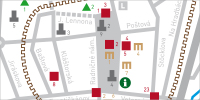|
 
           
|
“All the countries with the political system of people’s democracy change due to their commitment to build socialism. Social-economic and cultural-political reconstruction of old cities, and development of the new socialist cities runs rapidly. In the recent past, it was the cities of people’s democracy countries that were centers of blue collars persecution and exploitation of peasants, of phony bourgeoisie and bureaucracy, edgy soldiers and top class clergy. Nowadays, in the people’s democracy establishment these cities change their social-economic shape quickly and serve as models for the villages on the way of socialist reconstruction.”
Mesto: Stavba miest (1955)
This is a then quote, illustrating the interpretation of local reality at the time. The message was clear – dark past has gone, let’s build a better tomorrow! Of course, a smile on your face and random work tool in your hand is expected. An era of socialism, communism, and dictatorship of proletariat began. After World War II, the Middle Europe was swept by the Red Dragon and the little town of Bardejov was mercilessly adjoined to its mighty empire.
All of sudden, the good old times had to wave good-bye. After elimination of the critical voices and nationalization of every valuable private property, the great socialist redevelopment could be finally commenced. A warworn city started to grow fast and absorbed a massive number of people from the surrounding villages.
|
Mass construction of industrial factories and social accommodation during four decades of Communist dictatorship multiplied the number of Bardejov citizens four times.
In 1950, the historical center of Bardejov was declared an urban conservation area and therefore it has remained untouched by building operations of socialist realism. On the contrary, sights and monuments of former medieval town were being renovated. The most noticeable action was the restoration of fortification system and removing a near-by built-up area. These efforts reached their pinnacle in 1986, when International Council on Monuments and Sites (UNESCO/ICOMOS) awarded Bardejov the European Gold Medal for preservation and renewal of historical monuments.
On the other hand, the rest of the town was completely remodeled and conversed, which was in a strict contradiction to what was happening within town center (restoration and renovation). The infrastructure and development plans were significantly changed. The urban areas were functionally arranged, the new housing estates were built together with social accommodation, and industrial zones. Nevertheless, it was the construction of prefabricated houses of flats in 70’s and 80’s (typical of the countries within socialist region) that had the most significant impact on the general look of the town.
Buildings like Športová hala Mier (Mier Sport Hall), Námestie SNP (Slovak National Uprising Square), administration building of shoe producer JAS, or multifunctional complex of railway and bus station, rank among the most architectonically remarkable objects in the town.
|
Other valuable examples of the socialist architecture can be found in nearby Bardejov Spa. First of all, it’s the Colonnade, built at the 725th Anniversary of founding the Spa, which is considered to be the first building of its kind in Slovakia. It was built in 1972, together with a concert pavilion and promenade. But there are more significant socialist objects – Kúpeľný dom (Spa House), Hotel Ozón, Kino Žriedlo cinema, or Shopping and Services Centre. After its reconstruction, the Bardejov Spa became one of the most renowned spa resorts in former Czechoslovakia.
However, Bardejov has always been profiting mostly from industrial development. The city focused mainly on shoemaking and industrial engineering, there was also a bakery, dairy, sport equipment production, or cut glass factory. After the fall of socialist regime, many of these firms and companies fell victim to heavily reduced production that forced them to cease their business.
A few decades have passed since then, and the result is that the era of socialism has undoubtedly embedded in the town of Bardejov its cultural and historical features, with all its essential benefits and drawbacks. No matter how critically we perceive this era and its destructive ideology, it is obvious that a certain part of its heritage, mostly architectonical, has an incalculable value and potential to reasonable utilization.
Translated by:
Mgr. Tomáš Fedorko
|



















